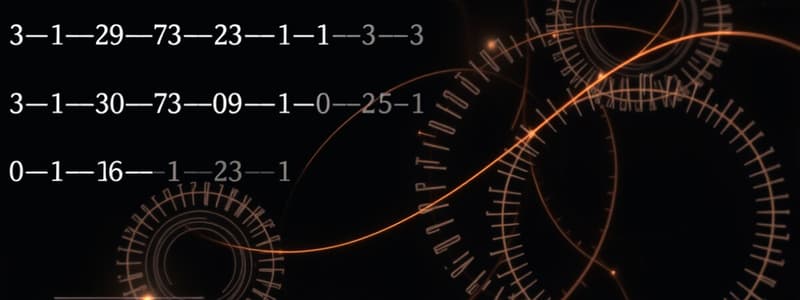Podcast
Questions and Answers
Is it true that every permutation can be expressed in a product of disjoint cycles?
Is it true that every permutation can be expressed in a product of disjoint cycles?
- True
- False (correct)
Every cycle is a permutation.
Every cycle is a permutation.
True (A)
The definition of even and odd permutations could have been given equally well before theorem 9.15.
The definition of even and odd permutations could have been given equally well before theorem 9.15.
False (B)
Every nontrivial subgroup H of S9 containing some odd permutation contains a transposition.
Every nontrivial subgroup H of S9 containing some odd permutation contains a transposition.
A5 has 120 elements.
A5 has 120 elements.
Sn is not cyclic for any n greater than or equal to 1.
Sn is not cyclic for any n greater than or equal to 1.
A3 is a commutative group.
A3 is a commutative group.
S7 is isomorphic to the subgroup of all those elements of S8 that leave the number 8 fixed.
S7 is isomorphic to the subgroup of all those elements of S8 that leave the number 8 fixed.
S7 is isomorphic to the subgroup of all those elements of S8 that leave the number 5 fixed.
S7 is isomorphic to the subgroup of all those elements of S8 that leave the number 5 fixed.
The odd permutation in S8 form a subgroup of S8.
The odd permutation in S8 form a subgroup of S8.
Flashcards are hidden until you start studying
Study Notes
Permutations and Cycles
- Every permutation can be expressed as a product of disjoint cycles.
- Specifically, not every permutation is a cycle.
Characteristics of Cycles
- A cycle is characterized as a permutation with at most one orbit containing more than one element.
- This confirms cycles are a subset of permutations.
Even and Odd Permutations
- The classification of permutations as even or odd is dependent on whether they can be expressed as a product of an even or odd number of transpositions.
- The definition of even and odd permutations requires prior theorem establishment; thus, the statement is false.
Subgroups and Odd Permutations
- Any nontrivial subgroup of S9 that contains an odd permutation must also contain a transposition. This is proven false by the existence of a subgroup formed solely by the odd permutation (1, 2, 3, 4) without transpositions.
Order of A5
- The order of the alternating group A5 is not 120; it is calculated as ( \frac{5!}{2} = 60 ).
Cyclic Nature of Sn
- The symmetric group S2 is cyclic due to its two-element structure; thus, the claim that Sn is not cyclic for any n (greater than or equal to) 1 is incorrect.
Group Properties of A3
- A3 has three elements, derived from the order ( \frac{3!}{2} = 3 ), confirming A3 is a cyclic and hence commutative group.
Isomorphism in Symmetric Groups
- S7 is isomorphic to the subgroup of S8 that fixes the number 8, showcasing a relationship between the groups based on the fixed elements.
- Similarly, S7 is also isomorphic to the subgroup of S8 that fixes the number 5.
Subgroup of Odd Permutations
- The set of odd permutations in S8 does not form a subgroup because it lacks the identity permutation (which is even).
Studying That Suits You
Use AI to generate personalized quizzes and flashcards to suit your learning preferences.



